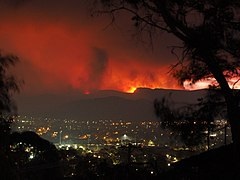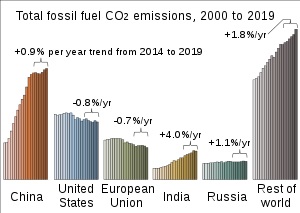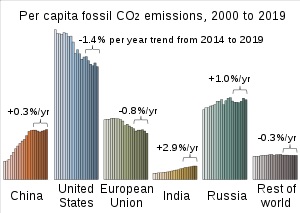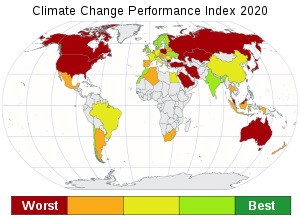|
|
| |
|
|
| |
|
|
|
|
| |
 |
| Extreme weather.
Drought and high temperatures worsened the 2020
bushfires in Australia. |
Global Warming
Global warming is the temperature of Earth's surface,
oceans and atmosphere going up over tens to thousands of
years. Average temperatures today are about 1 °C (1.8
°F) higher than before the Industrial Revolution, which
started around 1750, during the Little Ice Age, an
abnormally cold period. But in some parts of the world
it is less than this and some more. Some scientists say
that by the year 2100 temperatures will be 1.5 °C (2.7
°F) to 5 °C (9.0 °F) higher than they were before 1750.
The most noticeable changes because of this increase in
temperature is the melting of ice caps all around the
world. Sea level is rising steadily because of
continental ice melting into the sea. Many cities will
be partly flooded by the ocean in the 21st century.
Humans are primarily the cause of global warming.
Among the greenhouse gases, the increase of carbon
dioxide in the atmosphere is one of the causes of global
warming, as predicted by Svante Arrhenius a hundred
years ago, confirming the work of Joseph Fourier more
than 200 years ago. When people burn fossil fuels like
coal, oil and natural gas this adds carbon dioxide into
the air. This is because fossil fuels contain lots of
carbon and burning means joining most of the atoms in
the fuel with oxygen. When people cut down many trees
(deforestation), this means less carbon dioxide is taken
out of the atmosphere by those plants. |
 |
| Since 2000, rising
CO2 emissions in China and the rest of world
have surpassed the output of the United States
and Europe. |
As the Earth's surface temperature becomes hotter the
sea level becomes higher. This is partly because water
expands when it gets warmer. It is also partly because
warm temperatures make glaciers and ice caps melt. The
sea level rise causes coastal areas to flood. Weather
patterns, including where and how much rain or snow
there is, are changing. Deserts will probably increase
in size. Colder areas will warm up faster than warm
areas. Strong storms may become more likely and farming
may not make as much food. These effects will not be the
same everywhere. The changes from one area to another
are not well known.
People in government and the Intergovernmental Panel on
Climate Change (IPCC) are talking about global warming.
But governments, companies, and other people do not
agree on what to do about it. Some things that could
reduce warming are to burn less fossil fuels, grow more
trees, eat less meat, and put some carbon dioxide back
in the ground. Shading the Earth from some sunlight
(this is called geoengineering) could also reduce
warming but we don't understand how it might change
weather in other ways. Also people could adapt to any
temperature changes. The Kyoto Protocol and Paris
Agreement try to reduce pollution from the burning of
fossil fuels. Most governments have agreed to them but
some people in government think nothing should change.
The gas produced by cows digestion also causes global
warming, because it contains a greenhouse gas called
methane. |
|
 |
| Per person, the
United States generates CO2 at a far faster rate
than other primary regions. |
Temperature changes
Climate change has happened constantly over the history
of the Earth, including the coming and going of ice
ages. But modern climate change is different because
people are putting carbon dioxide into the atmosphere
very quickly.
Since the 1800s, people have recorded the daily
temperature. By about 1850, there were enough places
measuring temperature so that scientists could know the
global average temperature. Compared with before people
started burning a lot of coal for industry, the
temperature has risen by about 1 °C (1.8 °F). Starting
in 1979, satellites started measuring the temperature of
the Earth.
Before 1850, there were not enough temperature
measurements for us to know how warm or cold it was.
Climatologists use proxy measurements to try to figure
out past temperatures before there were thermometers.
This means measuring things that change when it gets
colder or warmer. One way is to cut into a tree and
measure how far apart the growth rings are. Trees that
live a long time can give us an idea of how temperature
and rain changed while it was alive.
For most of the past 2000 years the temperature didn't
change much. There were some times where the
temperatures were a little warmer or cooler. One of the
most famous warm times was the Medieval Warm Period and
one of the most famous cool times was the Little Ice
Age. Other proxy measurements like the temperature
measured in deep holes mostly agree with the tree rings.
Tree rings and bore holes can only help scientists work
out the temperature back to about 1000 years ago. Ice
cores are also used to find out the temperature back to
about half a million years ago.
The greenhouse effect
Coal-burning power plants, car exhausts, factory
smokestacks, and other man-made waste gas vents give off
about 23 billion tons of carbon dioxide and other
greenhouse gases into the Earth's atmosphere each year.
The amount of CO2 in the air is about 31% more than it
was around 1750. About three-quarters of the CO2 that
people have put in the air during the past 20 years are
due to burning fossil fuel like coal or oil. The rest
mostly comes from changes in how land is used, like
cutting down trees.
The Sun
The sun gets a little bit hotter and colder every 11
years. This is called the 11-year sunspot cycle. The
change is so small that scientists can barely measure
how it affects the temperature of the Earth. If the sun
was causing the Earth to warm up, it would warm both the
surface and high up in the air. But the air in the upper
stratosphere is actually getting colder, so scientists
do not think changes in the sun have much effect. In
addition, over hundreds of millions of years, the sun is
slowly getting brighter.
Dust and dirt
Dust and dirt in the air may come from natural sources
such as volcanos, erosion and meteoric dust. Some of
this dirt falls out within a few hours. Some is aerosol,
so small that it could stay in the air for years. The
aerosol particles in the atmosphere make the earth
colder. The effect of dust therefore cancels out some of
the effects of greenhouse gases. Even though humans also
put aerosols in the air when they burn coal or oil this
only cancels out the greenhouse effect of the fuel
burning for less than 20 years: the carbon dioxide stays
in the atmosphere much longer and keeps on warming the
earth. |
|
 |
| The Climate Change
Performance Index ranks countries by greenhouse
gas emissions (40% of score), renewable energy
(20%), energy use (20%), and climate policy
(20%). |
Some responses
Some people try to stop global warming, usually by
burning less fossil fuel. Many people have tried to get
countries to emit less greenhouse gases. The Kyoto
Protocol was signed in 1997. It was meant to reduce the
amount of greenhouse gases in the atmosphere to below
their levels in 1990. However, carbon dioxide levels
have continued to rise.
Energy conservation is used to burn less fossil fuel.
People can also use energy sources that don't burn
fossil fuel, like hydrogen, solar panels or electricity
from nuclear power or wind power. Or they can prevent
the carbon dioxide from getting out into the atmosphere,
which is called carbon capture and storage (CCS).
People can also change how they live because of any
changes that global warming will bring. For example,
they can go to places where the weather is better, or
build walls around cities to keep flood water out. Like
the preventive measures, these things cost money, and
rich people and rich countries will be able to change
more easily than the poor. Geoengineering is also seen
by some as one climate change mitigation response. For
example, a process using nanotechnology has been found
to remove carbon dioxide from the air to create ethanol.
History of climate change
science
As early as the 1820s a lot of scientists were finding
out about climate change. Joseph Fourier believed that
light from the sun can enter the atmosphere, but cannot
leave nearly as easily. He tried to prove that air can
absorb the infrared radiation and will be given back to
the Earth’s surface. Later in 1859, John Tyndall
discovered that water vapor and CO2 trap heat waves
given by the sun. In 1896, Svante Arrhenius tried to
prove that it would take thousands of years for the
industrial production of CO2 to raise the Earth’s
temperature 5-6°C. But throughout the early 20th century
many people did not believe this idea because it was too
simple. In the mid 20th century, scientists worked out
that there was a 10% increase in carbon dioxide in the
atmosphere over the 19th century, which made it a little
bit warmer. It was at this time that people believed the
emissions of CO2 would increase exponentially in the
future and the oceans would absorb any surplus of
greenhouse gases. In 1956, Gilbert N. Plass decided that
greenhouse gas emissions will have an effect on the
Earth’s temperature and argued that not thinking about
GHG emissions would be a mistake. Soon after, scientists
studying all different kinds of science began to work
together to figure out the mystery of GHG emissions and
their effects. As technology advanced, it was in the
1980s that there was proof of a rise in CO2 levels. An
ice core, captured through drilling, provided clear
evidence that carbon dioxide levels have risen. |
|
Effects of global warming on
sea levels
Global warming means that Antarctica and Greenland ice
sheets are melting and the oceans are expanding. Recent
climate change would still cause a 6 meters (20 ft)
sea-level rise even if greenhouse gas emissions were
reduced in 2015 per a scientific paper in Science.
Low-lying areas such as Bangladesh, Florida, the
Netherlands and other areas face massive flooding. |
|
 Kiddle: Global Warming Kiddle: Global Warming
Wikipedia: Global Warming |
|
|
|
|
|
|
|
|
|
|
|
|
|
|
|
|
Search Fun Easy English |
|
|
|
|
|
|
|
|
|
|
|
|
|
|
|
About
Contact
Copyright
Resources
Site Map |